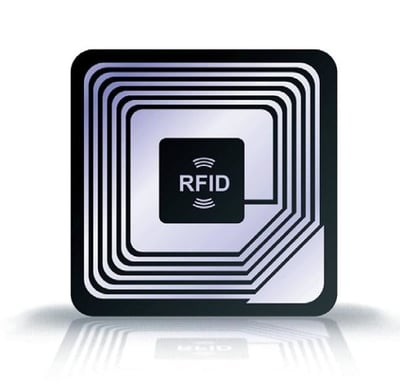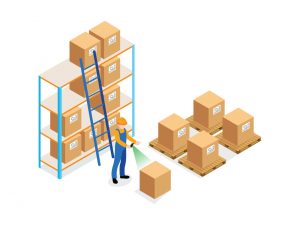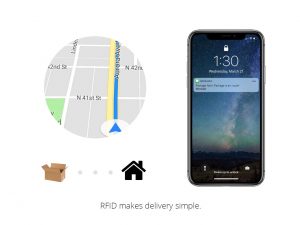What are RFID Tags?

Radio-Frequency Identification Tags, commonly known as RFID tags, are an up and coming technology that is expected to skyrocket in future years. What are RFID tags, and how can they be used? RFID tags are created using printed antennas with a microscopic chip that transmits a radio frequency signal.
RFID tags have 3 common frequency ranges of operation; Low frequency (125 kHz – 134 kHz), High Frequency (13.56 MHz), and Ultra High Frequency (860-960 MHz) and are commonly used to track an item’s location.
An example of an RFID tag that everyone has been exposed to before are the labels you see on items in your local retail stores. Those labels are being used to track the item’s location and ensure that theft doesn’t occur.
Although RFID tags are commonly used within retail stores, the application opportunities for them are endless. What is the newest up and coming industry for RFID tags? The Logistics industry!
4 Uses of RFID Tags in the Logistics Industry
RFID tags are expected to expand drastically as a market within the next few years. This is primarily because of the expected market for “Smart Packaging”, or the use of RFID tags within the Logistics and Distribution industry. The future of RFID tags is the concept of implementing them into packages being delivered, which would make monitoring inventory, location tracking, tamper control, and security all quickly and easily accessible.
1. Monitoring Inventory
When it comes to monitoring inventory, it can become a very tedious task. This is especially true because you have to constantly be aware of the inventory being shipped into and being shipped out of warehouses. However, with the use of RFID tags, that hassle can be easily eliminated.
RFID tags make it possible to track a package’s location throughout warehouses. This is because each individual warehouse has an RFID reader, and each individual package has an RFID tag. The RFID tags are automatically scanned by the RFID reading device upon entering and exiting the warehouse.
But what is the best part of RFID tags within inventory? The fact that the individual scanning of each package is not necessary. This is made possible because the RFID reader knows immediately when the package has entered or left the warehouse through the use of radiofrequency monitoring.
Not only does the use of RFID tags help to eliminate human error, but they are more efficient and accurate, helping to enhance the delivery time and delivery rate of packages to consumers.

2. Location Tracking
What if you could eliminate the hassle of “Tracking Your Order” through the individual carrier who is delivering your package? With the use of RFID tags, tracking a package’s location has become easily accessible, all at the click of a phone. Alerts are now capable of being sent to a phone as to where the package currently is in transit or the expected delivery date. Further down the road, there could even be an app created to track the location of the package, which could eliminate the need for “Tracking Numbers” or the online tracking of your order.
Location tracking is not only a positive for the consumer being able to track their package’s location, but it also helps delivery drivers with monitoring package location while in transit. Just as the warehouses have RFID reading devices to monitor packages entering and leaving the warehouse, delivery trucks are now capable of having the same. This eliminates the needs for the scanning of the packages, as the RFID reader immediately knows when the package has been placed in, or taken out, of the truck.
However, location tracking doesn’t end there. RFID tags are also capable of monitoring a delivery truck’s journey through transit. With the use of an RFID tag, just as that of an EZ Pass for Turnpikes, there can be “checkpoints” that have RFID scanners implemented within them. As the truck passes through the checkpoint, the RFID scanner will be able to scan the RFID tag within the truck. This makes it possible to monitor a truck’s route through transit, keeping both the customers and the delivery company aware of where exactly the packages are in the delivery process.

3. Tamper Control
For consumers, package theft, or tampered with and damaged packages, are a huge concern. With the use of RFID tags however, these concerns can be minimized.
RFID tags can be thought of as a “digital seal” for packages. If a package has been opened or tampered with while an RFID tag is located on the seal, the signal will be lost with the package. This is because once the RFID tag has been tampered with, the circuitry within the RFID tag will have also been destroyed, cutting off the signal to the package. If the signal to the package has been cut off, you will automatically know that your package has been tampered with through alerts being sent to your phone. This would also make it possible to get the suspicious activity reported quickly.
4. Security
Because of all the previous benefits listed for using RFID tags within the shipping industry, it’s no surprise that security is also a positive to their use. Because you can easily track a package’s location, you can also easily tell if the package has been opened or stolen. As a consumer, you’d also have the capability to report the lost, stolen, or opened package immediately. The use of the RFID tags within packages ensures that only the receiving party of the shipment opens the package, adding an element of security to the shipment for consumers when placing orders.
Final Thought:
RFID tags are a rapidly growing technology that is expected to boom over the next few years. According to IDTechEx, by the end of 2019 the total RFID market will be worth $11.6 billion, and by the year 2022, the market will grow to over $13 billion. Because of their simplicity, and the fact they can be attached to just about anything to make location easily trackable, the opportunities for their use are constantly expanding.
Can you think of any other possible markets for RFID tags? Reach out to our team for your next RFID project. We’ll be happy to help!
 Meet the Author: Jaclyn King
Meet the Author: Jaclyn King
Jaclyn is a Digital Marketing Specialist on the BTI Team. Her main job responsibilities involve inbound marketing, content creation, and social media management. To get to know more about Jaclyn, check her out on LinkedIn!